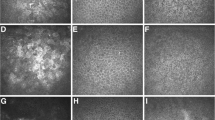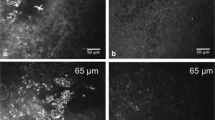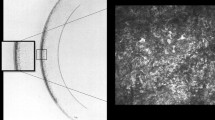Abstract
Background
We carried out an investigation into the morphological and quantitative corneal properties in dry eye with various underlying pathologies.
Methods
Ten patients with aqueous tear deficiency, 8 with dysthyroid ophthalmopathy, 8 with chronic lagophthalmos and 10 normal participants were examined. Confocal microscope images were taken at the centre and at the lower and upper periphery of the cornea. Quantitative and morphological assessments of the epithelium, of the sub-basal nerves, of the stroma and the endothelium were made. The epithelial and corneal thicknesses were measured.
Results
The mean superficial and intermediate epithelial cell densities in the central cornea in the patient groups were significantly lower than in normal participants (p<0.01). The peripheral epithelial thickness was smaller (p<0.01); it was smallest in the lagophthalmos group. The cornea was thinner in the patient groups (p<0.01). For sub-basal nerves, the density had decreased (p<0.05), and in lagophthalmos the number of beadlike formations had increased (p<0.001); in some patients we found irregular branching patterns.
Conclusions
Dry eye patients showed significant alterations in the cornea, presumably due to increased desquamation of the superficial cell layer. This was most pronounced at the lower periphery of the cornea in patients with exposure keratopathy.


Similar content being viewed by others
References
Benitez del Castillo JM, Wasfy MA, Fernandez C, Garcia-Sanchez J (2004) An in vivo confocal masked study on corneal epithelium and subbasal nerves in patients with dry eye. Invest Ophthalmol Vis Sci 45:3030–3035
Bron AJ, Evans VE, Smith JA (2003) Grading of corneal and conjunctival staining in the context of other dry eye tests. Cornea 22:640–650
Brooks AM, Grant G, Gillies WE (1987) Reversible corneal endothelial cell changes in diseases of the anterior segment. Aust N Z J Ophthalmol 15:283–289
Gilbard JP, Farris RL (1983) Ocular surface drying and tear film osmolarity in thyroid eye disease. Acta Ophthalmol (Copenh) 61:108–116
Grupcheva CN, Wong T, Riley AF, McGhee CN (2002) Assessing the sub-basal nerve plexus of the living healthy human cornea by in vivo confocal microscopy. Clin Exp Ophthalmol 30:187–190
Harrison DA, Joos C, Ambrosio R Jr (2003) Morphology of corneal basal epithelial cells by in vivo slit-scanning confocal microscopy. Cornea 22:246–248
Höh H, Schirra F, Kienecker C, Ruprecht KW (1995) Lid-parallel conjunctival folds are a sure diagnostic sign of dry eye. Ophthalmologe 92:802–808
Jalbert I, Stapleton F, Papas E, Sweeney DF, Coroneo M (2003) In vivo confocal microscopy of the human cornea. Br J Ophthalmol 87:225–236
Kallinikos P, Berhanu M, O’Donnell C, Boulton AJ, Efron N, Malik RA (2004) Corneal nerve tortuosity in diabetic patients with neuropathy. Invest Ophthalmol Vis Sci 45:418–422
Kaufman SC, Musch DC, Belin MW, Cohen EJ, Meisler DM, Reinhart WJ, Udell IJ, Van Meter WS (2004) Confocal microscopy: a report by the American Academy of Ophthalmology. Ophthalmology 111:396–406
Leduc C, Dupas B, Ott-Benoist AC, Baudouin C (2004) Advantages of the in vivo HRT2 corneal confocal microscope for investigation of the ocular surface epithelia. J Fr Ophtalmol 27:978–986
Li HF, Petroll WM, Møller-Pedersen T, Maurer JK, Cavanagh HD, Jester JV (1997) Epithelial and corneal thickness measurements by in vivo confocal microscopy through focusing (CMTF). Curr Eye Res 16:214–221
Liu Z, Pflugfelder SC (1999) Corneal thickness is reduced in dry eye. Cornea 18:403–407
McLaren JW, Nau CB, Erie JC, Bourne WM (2004) Corneal thickness measurement by confocal microscopy, ultrasound, and scanning slit methods. Am J Ophthalmol 137:1011–1020
Nichols KK, Nichols JJ, Mitchell GL (2004) The lack of association between signs and symptoms in patients with dry eye disease. Cornea 23:762–770
Patel SV, McLaren JW, Hodge DO, Bourne W (2001) Normal human keratocyte density and corneal thickness measurement by using confocal microscopy in vivo. Invest Ophthalmol Vis Sci 42:333–339
Rosenberg ME, Tervo TM, Immonen IJ, Muller LJ, Gronhagen-Riska C, Vesaluoma MH (2000) Corneal structure and sensitivity in type I diabetes mellitus. Invest Ophthalmol Vis Sci 41:2915–2921
Stave J, Zinser G, Grummer G, Guthoff R (2002) Modified Heidelberg Retinal Tomograph HRT. Initial results of in vivo presentation of corneal structures. Ophthalmologe 99:276–280
Tuominen IS, Konttinen YT, Vesaluoma MH, Moilanen JA, Helinto M, Tervo TM (2003) Corneal innervation and morphology in primary Sjögren’s syndrome. Invest Ophthalmol Vis Sci 44:2545–2549
Acknowledgement
The study was supported by grant no. 2/020/04 from the National Research and Technology Innovation Fund, Hungary.
Author information
Authors and Affiliations
Corresponding author
Additional information
The authors had no financial relationship with the organisation that supported the research.
The authors had full control of all primary data and agree to allow Graefe’s Archive for Clinical and Experimental Ophthalmology to review the data if requested.
Rights and permissions
About this article
Cite this article
Erdélyi, B., Kraak, R., Zhivov, A. et al. In vivo confocal laser scanning microscopy of the cornea in dry eye. Graefe's Arch Clin Exp Ophthalmol 245, 39–44 (2007). https://doi.org/10.1007/s00417-006-0375-6
Received:
Revised:
Accepted:
Published:
Issue Date:
DOI: https://doi.org/10.1007/s00417-006-0375-6




